Analysis of Uneven Settlement of Long-Span Bridge Foundations Based on SBAS-InSAR
Abstract
1. Introduction
2. Study Area and Data
2.1. Study Area
2.2. Datasets
3. Methodology
3.1. Principle of SBAS-InSAR
3.2. SBAS-InSAR Data Processing
- (1)
- Generation of Interferometric Pairs: Automatically select the SAR image acquired on 10 July 2021 as the super master image. Using this master image as a reference, co-register and resample it with the other 19 SAR images separately to form N interferometric pairs. Each pair contains phase information of the same surface area at different times.
- (2)
- Interferometric Processing: Perform interferometric processing on each interferometric pair, including phase unwrapping and interferogram generation. The phase in the interferogram contains surface deformation information but is also affected by factors such as atmospheric delays and topographic fluctuations [51]. Statistical or physical models are used to estimate and correct atmospheric delays, reducing the impact of atmospheric effects on the interferometric phase.
- (3)
- Deformation Inversion: Use a robust linear model to invert surface deformation. Based on the acquisition of linear deformation of the surface, the Singular Value Decomposition (SVD) method is employed to derive the nonlinear deformation of the surface, and the linear deformation is added to the nonlinear deformation to obtain a comprehensive representation of the deformation information. During the first inversion, the displacement rate and residual topography are estimated. In the second inversion, based on the deformation rate from the first inversion, perform high-pass filtering in the temporal dimension and low-pass filtering in the spatial dimension to estimate and remove the atmospheric phase, thereby obtaining the final displacement results on a purer time series.
- (4)
- Geocoding: Geocode the SBAS-InSAR inversion results by converting the pixel coordinates of the SAR images into geographic coordinates (latitude and longitude) to facilitate analysis and interpretation. Remove outliers and interpolate the deformation results. The deformation produced by SBAS-InSAR is in the line-of-sight (LOS) direction.
3.3. Error Analysis of the Processing Procedure
3.4. The Topo-Hydrological Aspects
3.4.1. Topographic Wetness Index (TWI)
3.4.2. Sediment Transport Index (STI)
3.5. Statistical Methods
3.5.1. Time-Lagged Cross-Correlation (TLCC) and Windowed TLCC (WTLCC)
3.5.2. Variance Inflation Factor (VIF)
4. Result
4.1. Accuracy Verification
4.2. SBAS-InSAR Results
4.3. Time Series Cumulative Deformation
4.4. Deformation Patterns Surrounding Bridge Foundations
5. Discussion
5.1. Relationship Between Uneven Bridge Foundation Settlement and Soil Layer Heterogeneity
5.2. Relationship Between Uneven Bridge Foundation Settlement and STI
5.3. Relationship Between Uneven Bridge Foundation Settlement and TWI
5.4. Relationship Between Uneven Bridge Foundation Settlement and Relative Humidity
5.5. Relationship Between Uneven Bridge Foundation Settlement and Temperature
5.6. Interactions Among Different Factors Affecting Settlement
6. Conclusions
- (1)
- Analysis of Uneven Foundation Settlement Using SBAS-InSAR Technology: The uneven foundation settlement of Huailai Bridge was analyzed using SBAS-InSAR technology. The results indicate that the north bank approach bridge foundation and the north side foundation of the main bridge generally exhibited an uplift trend. In contrast, the south side foundation of the main bridge and the south bank approach bridge foundation tended to subside, demonstrating a complex deformation pattern.
- (2)
- Influence of Various Factors on Foundation Settlement: By analyzing factors such as geological conditions, Sediment Transport Index (STI), Topographic Wetness Index (TWI), relative humidity, and temperature, we found that these factors may influence bridge foundation settlement. Stratigraphic heterogeneity, dynamic hydrological environments, and seasonal climate changes are potential causes of uneven settlement. Among the factors considered, relative humidity and temperature have a significant impact on foundation settlement.
- (3)
- Effectiveness of SBAS-InSAR Technology in Monitoring Dynamic Deformation: SBAS-InSAR technology can effectively monitor the dynamic deformation of bridges, providing reliable data support for bridge safety assessments. The results of this study indicate that SBAS-InSAR is an effective tool for surface deformation monitoring, providing a scientific basis for analysis and early warning of foundation settlement in long-span bridges.
Supplementary Materials
Author Contributions
Funding
Data Availability Statement
Acknowledgments
Conflicts of Interest
References
- Zhang, Z.; Leong, E.C.; Gong, W.; Dai, G.; Li, J. Foundation design of single-span arch bridges in China. Case Stud. Constr. Mater. 2023, 19, e02239. [Google Scholar] [CrossRef]
- Nolan, S.; Cadenazzi, T.; Rossini, M.; Nanni, A.; Knight, C.; Lasa, I. The 200-Year Bridge Substructure: Resilience and Sustainability; IABSE Congress: New York, NY, USA, 2019. [Google Scholar] [CrossRef]
- Ostenfeld, K.H. Evolution of Bridge Foundations for Constructability, Economy, Substainability and Safety; IABSE: Lyngby, Demark, 1999; pp. 7–12. [Google Scholar] [CrossRef]
- Hu, X.; Assaad, R.H.; Hussein, M. Discovering key factors and causalities impacting bridge pile resistance using Ensemble Bayesian networks: A bridge infrastructure asset management system. Expert Syst. Appl. 2024, 238, 121677. [Google Scholar] [CrossRef]
- Zhang, D.; Xiong, W.; Ma, X.; Cai, C.S. Fragility Evaluation of Bridge Pile Foundation Considering Scour Development under Floods. J. Bridge Eng. 2024, 29, 04024052. [Google Scholar] [CrossRef]
- Reumers, P.; Lombaert, G.; Degrande, G. The effect of foundation–soil–foundation interaction on the response of continuous, multi-span railway bridges. Eng. Struct. 2024, 299, 117096. [Google Scholar] [CrossRef]
- Li, R.; He, Q.; Zhu, S.; Yan, J.; Zhai, W. A new methodology for pre-camber design of a long-span bridge considering dynamic train load and complex environmental effects. Eng. Struct. 2024, 302, 117349. [Google Scholar] [CrossRef]
- Wang, N.; Elgamal, A.; Lu, J. Seismic response of the Eureka Channel bridge-foundation system. Soil Dyn. Earthq. Eng. 2022, 152, 107015. [Google Scholar] [CrossRef]
- He, Q.; Wang, D.; Peng, N. Numerical analysis of influencing factors of uneven settlement in abutment foundation. Adv. Mat. Res. 2012, 422, 864–868. [Google Scholar] [CrossRef]
- Liu, F.; Zheng, G.; Cui, G. Settlement deformation characteristics and control of soft soil through groundwater discharge zone. Desalin. Water Treat. 2021, 241, 282–287. [Google Scholar] [CrossRef]
- Liu, W.; Yang, X.; Zhang, S.; Kong, X.; Chen, W. Analysis of Deformation Characteristics of Long-Short Pile Composite Foundation in Salt Lake Area, Iran. Adv. Civ. Eng. 2019, 2019, 5976540. [Google Scholar] [CrossRef]
- Du, Y.; He, X.; Wu, C.; Wu, W. Long-term monitoring and analysis of the longitudinal differential settlement of an expressway bridge–subgrade transition section in a loess area. Sci. Rep. 2022, 12, 19327. [Google Scholar] [CrossRef] [PubMed]
- Feng, Y.; Hou, Y.; Jiang, L.; Zhou, W.; Li, H.; Yu, J. Failure mode of interlayer connection of longitudinally-connected ballastless track-bridge system under uneven pier settlement. Constr. Build. Mater. 2022, 351, 128805. [Google Scholar] [CrossRef]
- Sun, H.; Chen, A.; Shi, L.; Cai, Y. Iterative method for predicting uneven bridge approach settlement (BAS) caused by vehicle loads. Math. Probl. Eng. 2020, 2020, 8476746. [Google Scholar] [CrossRef]
- Li, F.; Gong, H.; Chen, B.; Gao, M.; Zhou, C.; Guo, L. Understanding the influence of building loads on surface settlement: A case study in the central business district of Beijing combining multi-source data. Remote Sens. 2021, 13, 3063. [Google Scholar] [CrossRef]
- Wang, Y.; Zhou, H.; Wang, L. Settlement mode analysis for an immersed tube tunnel considering a nonuniform foundation under tidal load. China Ocean Eng. 2022, 36, 427–438. [Google Scholar] [CrossRef]
- Yang, W.; Ma, L. Research on Common Diseases and Construction Treatment Technologies in Road and Bridge Engineering. AJST 2024, 10, 42–45. [Google Scholar] [CrossRef]
- Fu, X.; Li, J.; Liu, J.; Hu, Z.; Tang, C. Influence of Complex Hydraulic Environments on the Mechanical Properties of Pile-Soil Composite Foundation in the Coastal Soft Soil Area of Zhuhai. Buildings 2023, 13, 563. [Google Scholar] [CrossRef]
- Wang, L.; Sun, G.; Xu, J.; Wu, X.; Hou, X.; Han, Z. Study on Arching Mechanism of Bridge Pile Foundation: Taking the Shiyangtai No. 1 Bridge as an Example. Buildings 2024, 14, 243. [Google Scholar] [CrossRef]
- Rakoczy, A.M.; Ribeiro, D.; Hoskere, V.; Narazaki, Y.; Olaszek, P.; Karwowski, W. Technologies and Platforms for Remote and Autonomous Bridge Inspection–Review. Struct. Eng. Int. 2024, 1–23. [Google Scholar] [CrossRef]
- Li, J.; Ma, L. Research on Quality Inspection and Reinforcement Technology of Road Bridge. AJST 2024, 10, 51–54. [Google Scholar] [CrossRef]
- Ozden, A.; Faghri, A.; Li, M.; Tabrizi, K. Evaluation of Synthetic Aperture Radar satellite remote sensing for pavement and infrastructure monitoring. Procedia Eng. 2016, 145, 752–759. [Google Scholar] [CrossRef]
- Lorenz, R.; Petryna, Y.; Lubitz, C.; Lang, O.; Wegener, V. Thermal deformation monitoring of a highway bridge: Combined analysis of geodetic and satellite-based InSAR measurements with structural simulations. J. Civ. Struct. Health Monit. 2024, 14, 1237–1255. [Google Scholar] [CrossRef]
- Ferretti, A.; Prati, C.; Rocca, F. Permanent scatterers in SAR interferometry. IEEE Trans. Geosci Remote Sens. 2001, 39, 8–20. [Google Scholar] [CrossRef]
- Hanssen, R.F. Satellite radar interferometry for deformation monitoring: A priori assessment of feasibility and accuracy. Int. J. Appl. Earth OBS 2005, 6, 253–260. [Google Scholar] [CrossRef]
- Martino, G.D.; Esposito, M.; Festa, B.; Iodice, A.; Mancini, L.; Poreh, D. Railway Bridge Monitoring with Sar: A Case Study. In Proceedings of the 2018 IEEE International Geoscience and Remote Sensing Symposium, Valencia, Spain, 22–27 July 2018; IEEE: Geneva, Switzerland, 2018; pp. 2952–2955. [Google Scholar] [CrossRef]
- Cusson, D.; Stewart, H. Satellite Synthetic Aperture Radar, Multispectral, and Infrared Imagery for Assessing Bridge Deformation and Structural Health—A Case Study at the Samuel de Champlain Bridge. Remote Sens. 2024, 16, 614. [Google Scholar] [CrossRef]
- Malinowska, D.; Milillo, P.; Briggs, K.; Reale, C.; Giardina, G. Coherence-Based Prediction of Multi-Temporal InSAR Measurement Availability for Infrastructure Monitoring. IEEE J. Sel. Top. Appl. Earth OBS Remote Sens. 2024, 17, 16392. [Google Scholar] [CrossRef]
- Lazecky, M.; Perissin, D.; Bakon, M.; De Sousa, J.M.; Hlavacova, I.; Real, N. Potential of satellite InSAR techniques for monitoring of bridge deformations. In Proceedings of the 2015 Joint Urban Remote Sensing Event (JURSE), Lausanne, Switzerland, 30 March–1 April 2015. [Google Scholar] [CrossRef]
- Selvakumaran, S.; Rossi, C.; Marinoni, A.; Webb, G.; Bennetts, J.; Barton, E. Combined InSAR and terrestrial structural monitoring of bridges. IEEE Trans. Geosci. Remote Sens. 2020, 58, 7141–7153. [Google Scholar] [CrossRef]
- Nettis, A.; Massimi, V.; Nutricato, R.; Nitti, D.O.; Samarelli, S.; Uva, G. Satellite-based interferometry for monitoring structural deformations of bridge portfolios. Automat. Constr. 2023, 147, 104707. [Google Scholar] [CrossRef]
- Matteo, D.S.; Roberto, T.; Javier, P.C.; Gerardo, H.G.; Juan Carlos, G.L.D.; Oscar, M. A multi-sensor approach for monitoring a road bridge in the Valencia harbor (SE Spain) by SAR Interferometry (InSAR). Rend. Online Soc. Geol. 2016, 41, 235–238. [Google Scholar] [CrossRef]
- Du, Y.; Feng, D.; Wu, G. InSAR-based rapid damage assessment of urban building portfolios following the 2023 Turkey earthquake. Int. J. Disaster Risk Reduct. 2024, 103, 104317. [Google Scholar] [CrossRef]
- Macchiarulo, V.; Milillo, P.; Blenkinsopp, C.; Reale, C.; Giardina, G. Multi-temporal InSAR for transport infrastructure monitoring: Recent trends and challenges. Proc. Inst. Civ. Eng.-BR 2021, 176, 92–117. [Google Scholar] [CrossRef]
- Zhao, X.; Zhu, S.; Sun, W.; Huang, Z. Application of PS-InSAR technology in bridge settlement deformation monitoring. CN11-4527/TU 2023, 41, 54–60. [Google Scholar] [CrossRef]
- Wang, C.; Zhou, L.; Ma, J.; Shi, A.; Li, X.; Liu, L.; Zhang, Z.; Zhang, D. GB-RAR deformation information estimation of high-speed railway bridge in consideration of the effects of colored noise. Appl. Sci. 2022, 12, 10504. [Google Scholar] [CrossRef]
- Selvakumaran, S.; Plank, S.; Geiß, C.; Rossi, C.; Middleton, C. Remote monitoring to predict bridge scour failure using Interferometric Synthetic Aperture Radar (InSAR) stacking techniques. Int. J. Appl. Earth OBS 2018, 73, 463–470. [Google Scholar] [CrossRef]
- Guzman-Acevedo, G.M.; Quintana-Rodriguez, J.A.; Gaxiola-Camacho, J.R.; Vazquez-Becerra, G.E.; Torres-Moreno, V.; Monjardin-Quevedo, J.G. The Structural Reliability of the Usumacinta Bridge Using InSAR Time Series of Semi-Static Displacements. Infrastructures 2023, 8, 173. [Google Scholar] [CrossRef]
- Jiang, H.; Balz, T.; Cigna, F.; Tapete, D.; Li, J.; Han, Y. Multi-sensor InSAR time series fusion for long-term land subsidence monitoring. Geo. Spat. Inf. Sci. 2023, 27, 1424–1440. [Google Scholar] [CrossRef]
- Zhao, C.; Peng, M.; Zhu, J. Application of Persistent Scatterer Interferometric Synthetic Aperture Radar in Bridge Settlement Monitoring. Road Mach. Constr. Mech. 2019, 36, 115–120. [Google Scholar] [CrossRef]
- Lasri, O.; Giordano, P.F.; Limongelli, M.P.; Previtali, M. Remote monitoring of a concrete bridge using PSInSAR. ce/papers 2023, 6, 893–899. [Google Scholar] [CrossRef]
- Ma, P.; Wu, Z.; Zhang, Z.; Au, F.T.K. SAR-Transformer-based decomposition and geophysical interpretation of InSAR time-series deformations for the Hong Kong-Zhuhai-Macao Bridge. Remote Sens. Environ. 2024, 302, 113962. [Google Scholar] [CrossRef]
- Du, Y.; Yan, S.; Zhao, F.; Chen, D.; Zhang, H. DS-InSAR based long-term deformation pattern analysis in the mining region with an improved phase optimization algorithm. Front. Environ. Sci. 2022, 10, 799946. [Google Scholar] [CrossRef]
- Li, S.; Xu, W.; Li, Z. Review of the SBAS InSAR Time-series algorithms, applications, and challenges. Geod. Geodyn. 2022, 13, 114–126. [Google Scholar] [CrossRef]
- Berardino, P.; Fornaro, G.; Lanari, R.; Sansosti, E. A new algorithm for surface deformation monitoring based on small baseline differential SAR interferograms. IEEE Trans. Geosci. Remote Sens. 2002, 40, 2375–2383. [Google Scholar] [CrossRef]
- Wang, R.; Feng, Y.; Tong, X.; Li, P.; Wang, J.; Tang, P.; Tang, X.; Xi, M.; Zhou, Y. Large-Scale Surface Deformation Monitoring Using SBAS-InSAR and Intelligent Prediction in Typical Cities of Yangtze River Delta. Remote Sens. 2023, 15, 4942. [Google Scholar] [CrossRef]
- Han, Z. Research on Surface Deformation Monitoring Using SBAS-InSAR: A Case Study of Zhujiang Bridge in Nansha District, Guangzhou. J. ACM 2023, 13, 1–6. [Google Scholar] [CrossRef]
- Zhou, L.; Li, X.; Pan, Y.; Ma, J.; Wang, W.; Shi, A.; Chen, Y. Deformation monitoring of long-span railway bridges based on SBAS-InSAR technology. Geod. Geodyn. 2024, 15, 122–132. [Google Scholar] [CrossRef]
- The Provincial Highway S228 Langzhen Line Huailai Bridge Officially Opened to Traffic Today! Available online: https://www.thepaper.cn/newsDetail_forward_13344674 (accessed on 6 October 2024).
- Yu, Z.; Zhang, G.; Huang, G.; Cheng, C.; Zhang, Z.; Zhang, C. SSBAS-InSAR: A Spatially Constrained Small Baseline Subset InSAR Technique for Refined Time-Series Deformation Monitoring. Remote Sens. 2024, 16, 3515. [Google Scholar] [CrossRef]
- He, Y.; Wang, W.; Zhang, L.; Chen, Y.; Chen, Y.; Chen, B.; He, X.; Zhao, Z. An identification method of potential landslide zones using InSAR data and landslide susceptibility. Geomat. Nat. Haz. Risk 2023, 14, 2185120. [Google Scholar] [CrossRef]
- Zhang, S.; Wang, J.; Feng, Z.; Wang, T.; Li, J.; Liu, N. Verification of the accuracy of Sentinel-1 for DEM extraction error analysis under complex terrain conditions. Int. J. Appl. Earth OBS Geoinf. 2024, 133, 104157. [Google Scholar] [CrossRef]
- Hu, H.; Fu, H.; Zhu, J.; Liu, J.; Wu, K.; Zeng, D.; Wan, A.; Wang, F. Automatic Correction of Time-Varying Orbit Errors for Single-Baseline Single-Polarization InSAR Data Based on Block Adjustment Model. Remote Sens. 2024, 16, 3578. [Google Scholar] [CrossRef]
- Feng, Y.; Zhou, Y.; Chen, Y.; Li, P.; Xi, M.; Tong, X. Automatic selection of permanent scatterers-based GCPs for refinement and reflattening in InSAR DEM generation. Int. J. Digit. Earth 2022, 15, 954–974. [Google Scholar] [CrossRef]
- Wang, Z.; Liu, F.; Zeng, T.; Wang, C. Interferometric phase error analysis and compensation in GNSS-InSAR: A case study of structural monitoring. Remote Sens. 2021, 13, 3041. [Google Scholar] [CrossRef]
- Gaurav Singh, V.; Singh, S.K. Analysis of geo-morphometric and topo-hydrological indices using COP-DEM: A case study of Betwa River Basin, Central India. Geol. Ecol. Landsc. 2024, 8, 101–128. [Google Scholar] [CrossRef]
- Liu, H.; Li, Y.; Liu, C.; Shen, G.; Xiang, H. Pavement distress initiation prediction by time-lag analysis and logistic regression. Appl. Sci. 2022, 12, 11855. [Google Scholar] [CrossRef]
- Chaikul, S.; Khunatorn, Y.; Phithakkitnukoon, S. A Study of Temporal Correlation Between Space Utilization and Electricity Consumption in Buildings Using Wi-Fi Probe Data. IEEE Access 2024, 12, 105792–105802. [Google Scholar] [CrossRef]
- Zhao, L.; Faust, R.A.; David, R.E.; Norton, J.; Xagoraraki, I. Tracking the Time Lag between SARS-CoV-2 Wastewater Concentrations and Three COVID-19 Clinical Metrics: A 21-Month Case Study in the Tricounty Detroit Area, Michigan. J. Environ. Eng. 2024, 150, 06023004. [Google Scholar] [CrossRef]
- Li, R.; Feng, K.; An, T.; Cheng, P.; Wei, L.; Zhao, Z.; Xu, X.; Zhu, L. Enhanced Insights into Effluent Prediction in Wastewater Treatment Plants: Comprehensive Deep Learning Model Explanation Based on SHAP. ACS EST Water 2024, 4, 1904–1915. [Google Scholar] [CrossRef]
- Zhang, Z.; Chen, G.; Kusky, T.; Yang, J.; Cheng, Q. Lithospheric thickness records tectonic evolution by controlling metamorphic conditions. Sci. Adv. 2023, 9, eadi2134. [Google Scholar] [CrossRef]
- Debnath, J.; Sahariah, D.; Nath, N.; Saikia, A.; Lahon, D.; Islam, M.N.; Hashimoto, S.; Meraj, G.; Kumar, P.; Singh, S.K.; et al. Modelling on assessment of flood risk susceptibility at the Jia Bharali River basin in Eastern Himalayas by integrating multicollinearity tests and geospatial techniques. Model. Earth Syst. Environ. 2024, 10, 2393–2419. [Google Scholar] [CrossRef]
- Zou, L.; Feng, W.; Masci, O.; Nico, G.; Alani, A.M.; Sato, M. Bridge Monitoring Strategies for Sustainable Development with Microwave Radar Interferometry. Sustain. Sci. 2024, 16, 2607. [Google Scholar] [CrossRef]
- Zhang, L.; Wu, X.; Chen, Q.; Skibniewski, M.J.; Hsu, S.C. Towards a safety management approach for adjacent buildings in tunneling environments: Case study in China. Build. Environ. 2014, 75, 222–235. [Google Scholar] [CrossRef]
- Mitchell, J.K.; Soga, K. Fundamentals of Soil Behavior, 3rd ed.; John Wiley & Sons, Ltd.: Hoboken, NJ, USA, 2005; pp. 18–25. Available online: https://istasazeh-co.com/wp-content/uploads/2022/04/Fundamentals-Of-Soil-Behavior-K-Mitchel.pdf (accessed on 11 November 2024).
- Nujid, M.M.; Tholibon, D.A.; Mukhlisin, M. Geotechnical and structural assessment on estimated bearing capacity of strip footing resting on silty sand incorporating moisture content effect. Case Stud. Constr. Mater. 2024, 20, e03106. [Google Scholar] [CrossRef]
- Hosseinpour, I.; Almeida, M.S.S.; Riccio, M.; Baroni, M. Strength and compressibility characteristics of a soft clay subjected to ground treatment. Geotech. Geol. Eng. 2017, 35, 1051–1066. [Google Scholar] [CrossRef]
- Mrad, D.; Boukhari, S.; Dairi, S.; Djebbar, Y. Mapping the Potential for Erosion Gullies Using Frequency Ratio and Fuzzy Analytical Hierarchy Process: Case Study Medjerda Basin, Northeast Algeria. Eurasian Soil Sci. 2024, 57, 1381–1391. [Google Scholar] [CrossRef]
- Yao, C.; Zhang, Q.; Wang, C.; Ren, J.; Li, H.; Wang, H.; Wu, F. Response of sediment transport capacity to soil properties and hydraulic parameters in the typical agricultural regions of the Loess Plateau. Sci. Total Environ. 2023, 879, 163090. [Google Scholar] [CrossRef]
- Hagiwara, T.; Aita, S.; Kazama, S. Impact of Filter Unit Placement on Suspended Sediment Deposition Promotion in Rivers. J. Hydraul. Eng. 2024, 150, 04024043. [Google Scholar] [CrossRef]
- Leopold, L.B.; Wolman, M.G.; Miller, J.P.; Wohl, E.E. Fluvial Processes in Geomorphology, 2nd ed.; Courier Dover Publications: New York, NY, USA, 2020; pp. 284–304. Available online: https://books.google.com.hk/books?hl=en&lr=&id=vnb2DwAAQBAJ&oi=fnd&pg=PA3&dq=fluvial+processes+in+geomorphology+2020&ots=znSNXNoq7g&sig=ZdNWbUiZjlWVul7IjMyUtxOmpjw&redir_esc=y#v=onepage&q=fluvial%20processes%20in%20geomorphology%202020&f=false (accessed on 11 November 2024).
- King, M.; Kim, B.J.; Yune, C.Y. Prediction model of undisturbed ground temperature using artificial neural network (ANN) and multiple regressions approach. Geothermics 2024, 119, 102945. [Google Scholar] [CrossRef]
- Hesterah, H.; Plantak, M.; Gernhardt, D. Correlations Between Topographic Wetness Index and Soil Moisture in The Pannonian Region of Croatia. Geogr. Tech. 2024, 19, 89–102. [Google Scholar] [CrossRef]
- Gidafie, D.; Nedaw, D.; Azagegn, T. Integrated remote sensing and geographic information system overlay analysis for groundwater potential evaluation using AHP and fuzzy AHP: Southern sections of the western Afar rift margin and associated rift floor. Groundw. Sustain. Dev. 2024, 26, 101310. [Google Scholar] [CrossRef]
- Kluger, M.O.; Jorat, M.E.; Moon, V.G.; Kreiter, S.; De Lange, W.P.; Mörz, T.; Robertson, T.; Lowe, D.J. Rainfall threshold for initiating effective stress decrease and failure in weathered tephra slopes. Landslides 2020, 17, 267–281. [Google Scholar] [CrossRef]
- Firoozi, A.A.; Firoozi, A.A. Water Erosion Processes: Mechanisms, Impact, and Management Strategies. Result Eng. 2024, 24, 103237. [Google Scholar] [CrossRef]
- Jabbar, M.; Nasar-u-Minallah, M.; Yusoff, M.M. Measuring and modeling the association between human psychological well-being and urban green spaces of Lahore, Pakistan. J. Environ. Stud. Sci. 2024, 14, 732–743. [Google Scholar] [CrossRef]
- Edmunds, N.S.; Genc, A.G.; McGuffin, L.J. Benchmarking of AlphaFold2 accuracy self-estimates as indicators of empirical model quality and ranking: A comparison with independent model quality assessment programmes. Bioinformatics. 2024, 40, btae491. [Google Scholar] [CrossRef]
- Jabbarzadeh, M.; Sadeghi, H.; Tourchi, S.; Darzi, A.G. Thermo-hydraulic analysis of desiccation cracked soil strata considering ground temperature and moisture dynamics under the influence of soil-atmosphere interactions. Geomech. Energy Environ. 2024, 38, 100558. [Google Scholar] [CrossRef]
- Richardson, C.M.; Davis, K.L.; Ruiz-González, C.; Guimond, J.A.; Michael, H.A.; Paldor, A.; Moosdorf, N.; Paytan, A. The impacts of climate change on coastal groundwater. Nat. Rev. Earth Environ. 2024, 5, 100–119. [Google Scholar] [CrossRef]
- Lei, B.; Song, Y. Volatility forecasting for stock market incorporating media reports, investors’ sentiment, and attention based on MTGNN model. J. Forecast. 2024, 43, 1706–1730. [Google Scholar] [CrossRef]
- Xuan, Y.; Zhu, G.; Luo, X.; Wang, Y.; Wang, L. Experimental Study on the Stability of Mixed-Flow Pump During Segmented Start-Up Process. Arab. J. Sci. Eng. 2024, 1–13. [Google Scholar] [CrossRef]
- Soumena, F.Y.; Umaima, U.; Nurwahida, N.; Syam, D.R.Y. The Influence of SME Funding and Non-Performing Financing on Indonesia’s Economic Growth in The Period 2015–2022. Return Stud. Manag. Econ. Bus. 2024, 3, 166–180. [Google Scholar] [CrossRef]
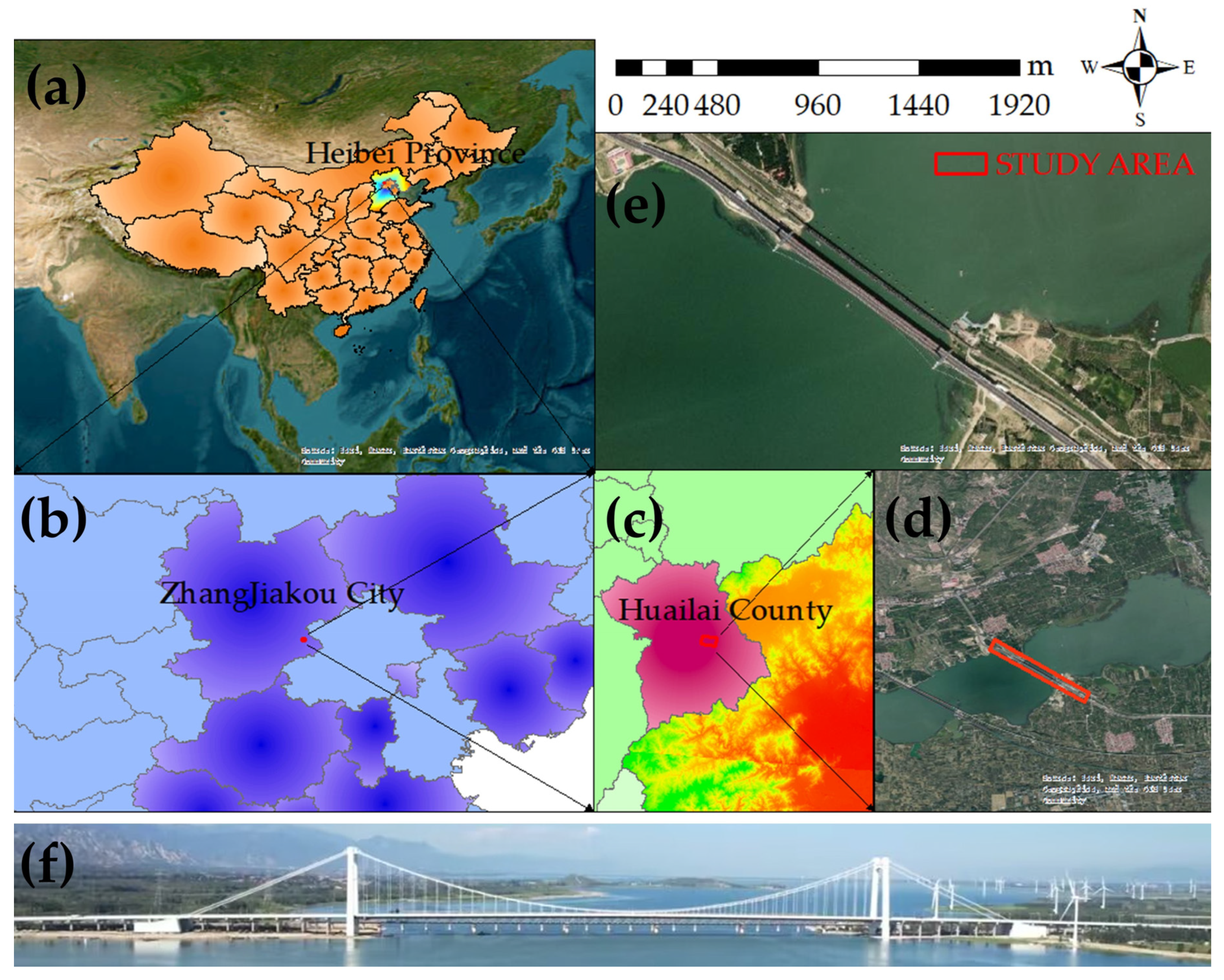


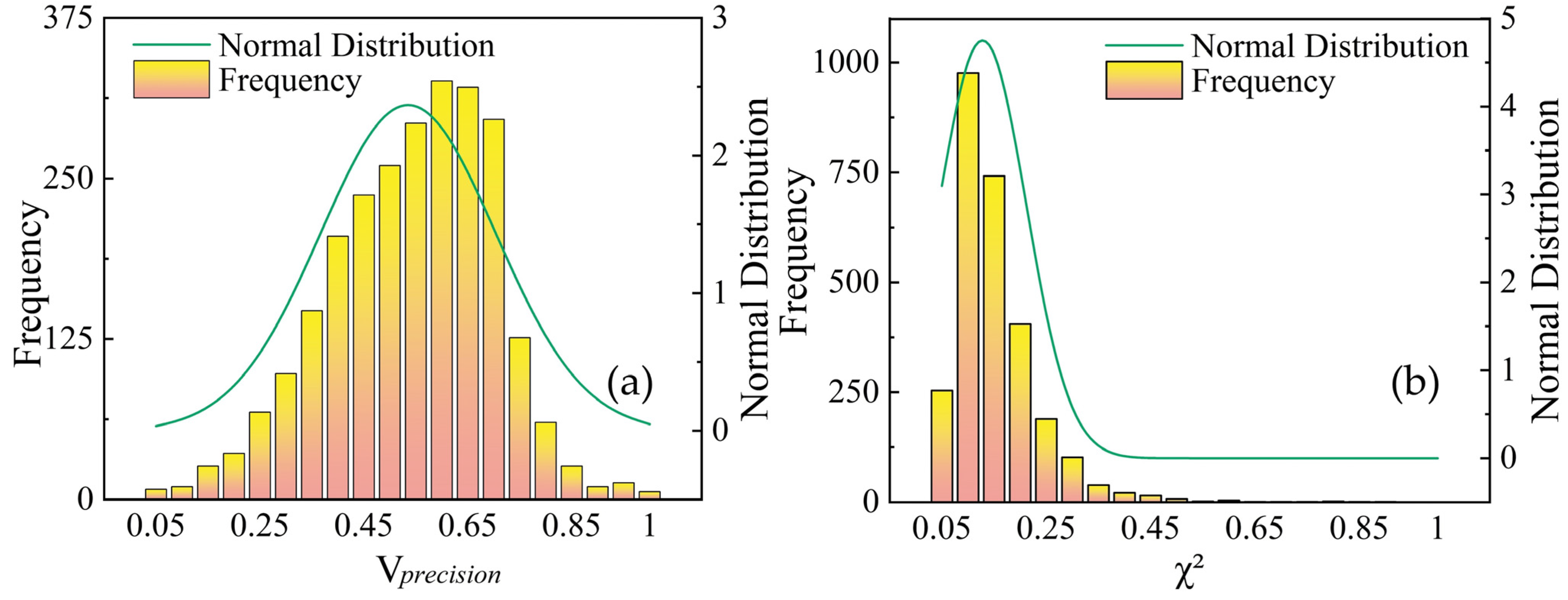
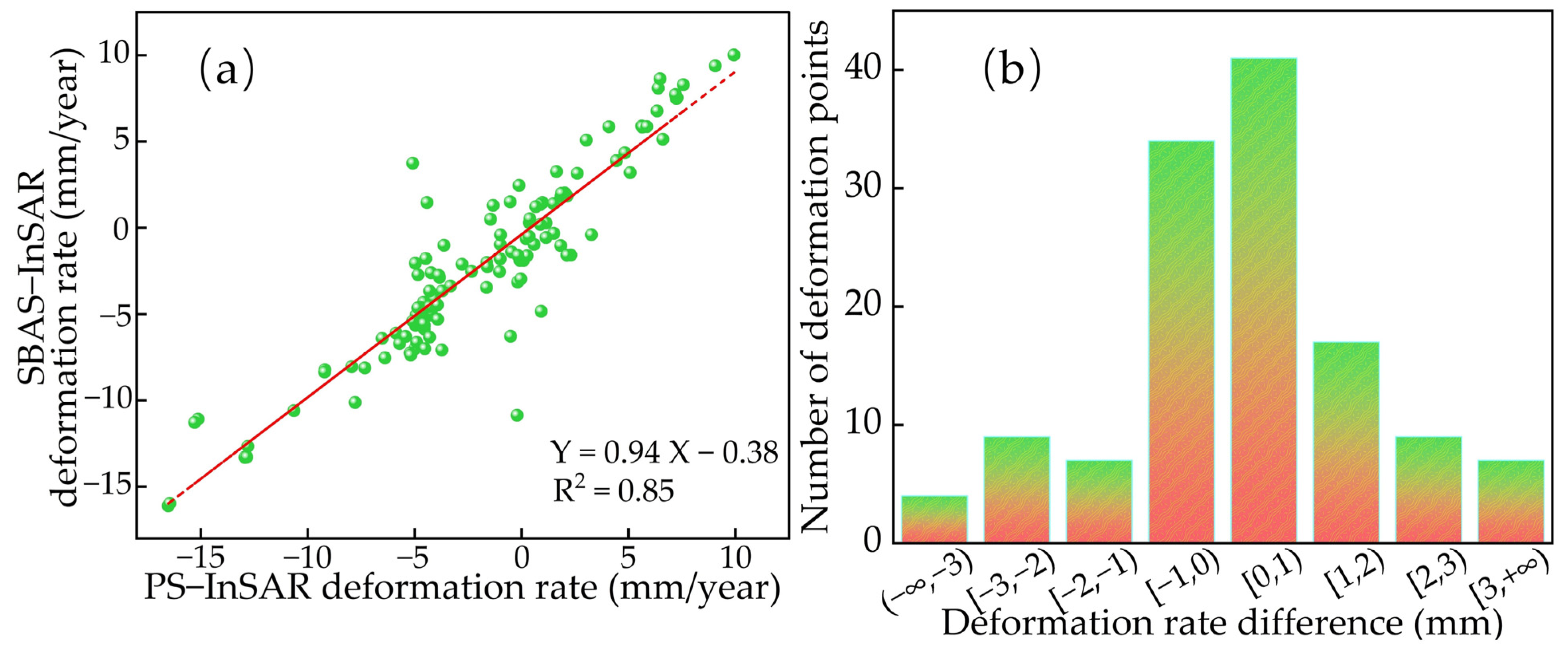

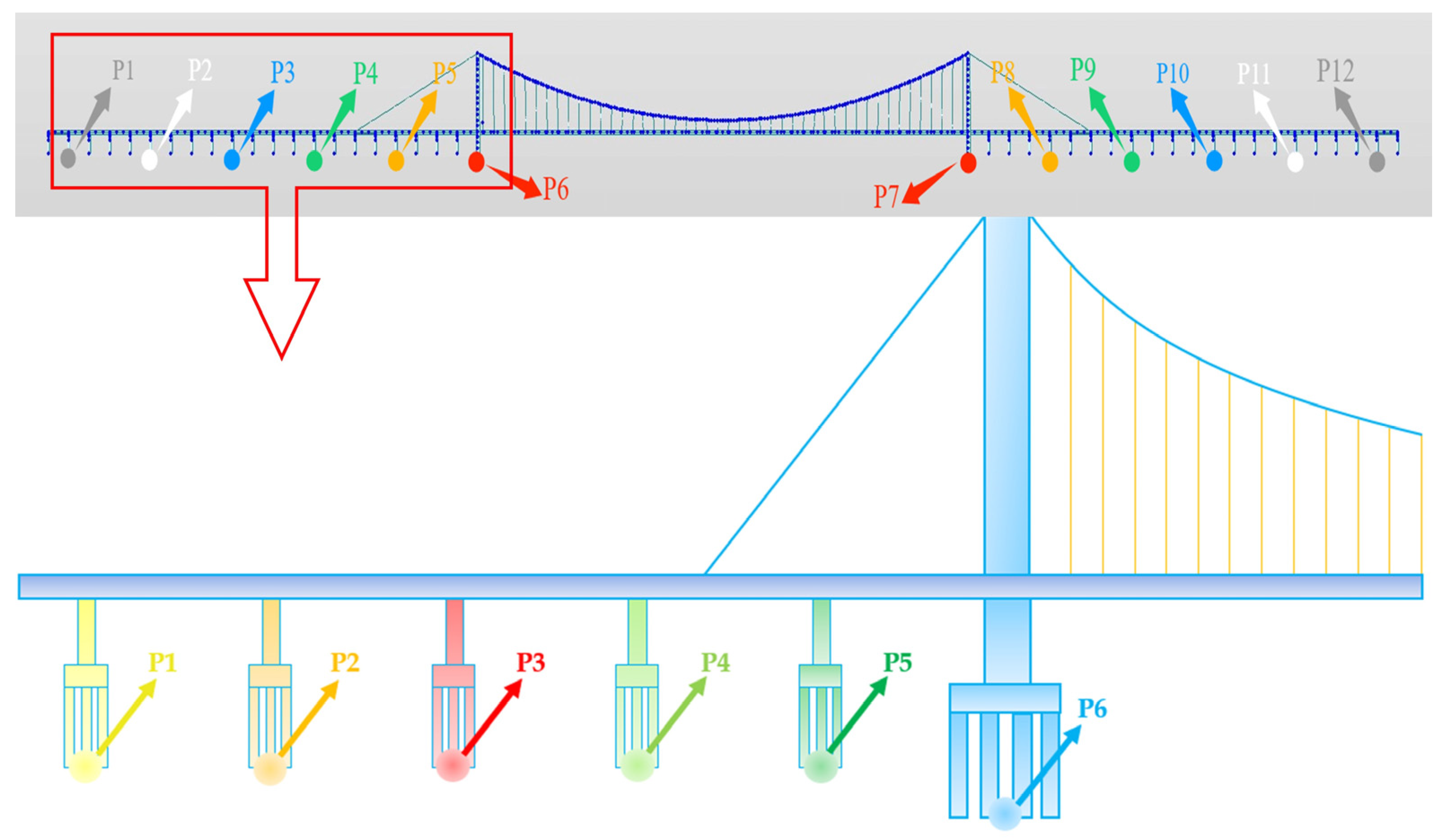
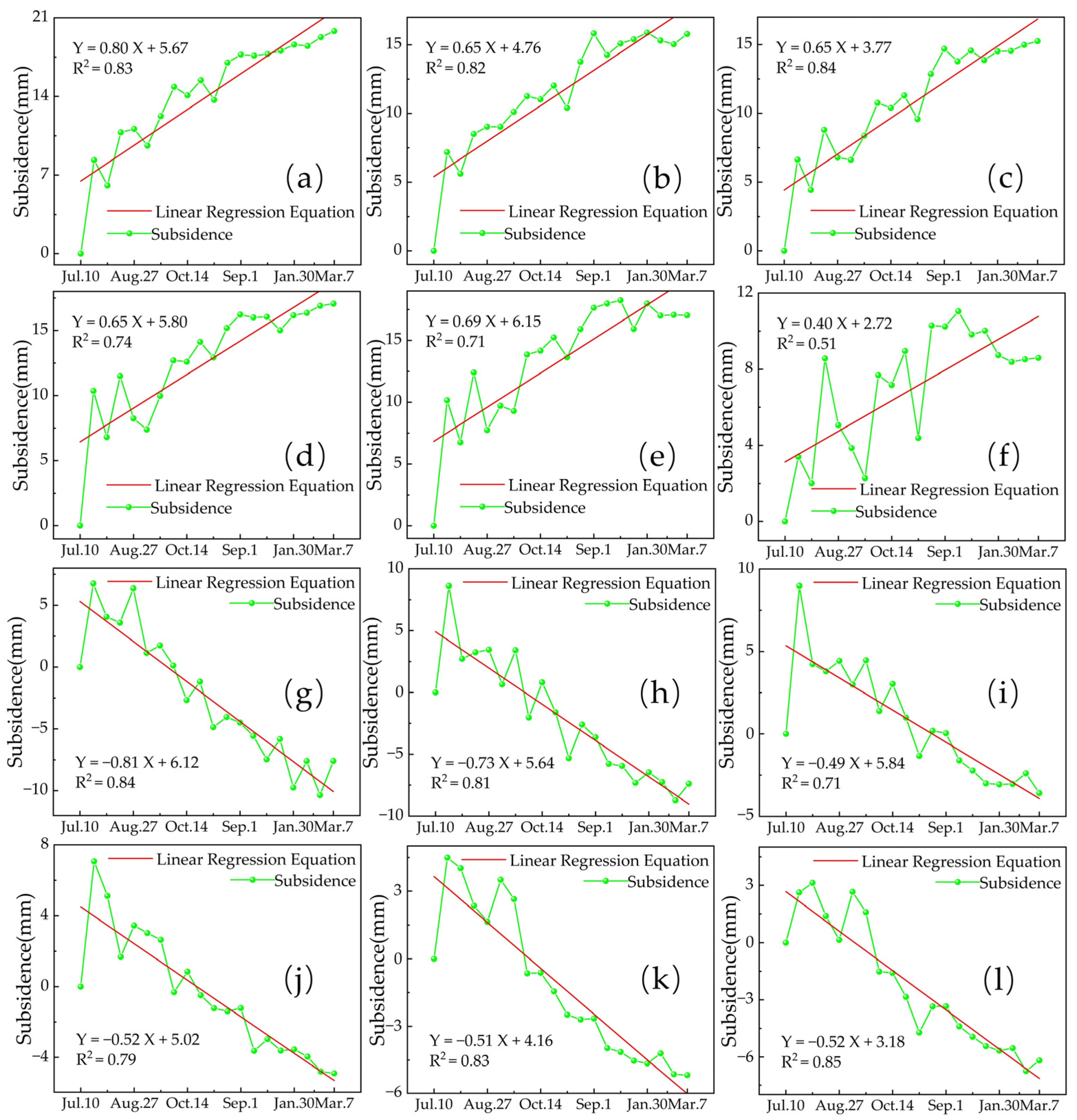
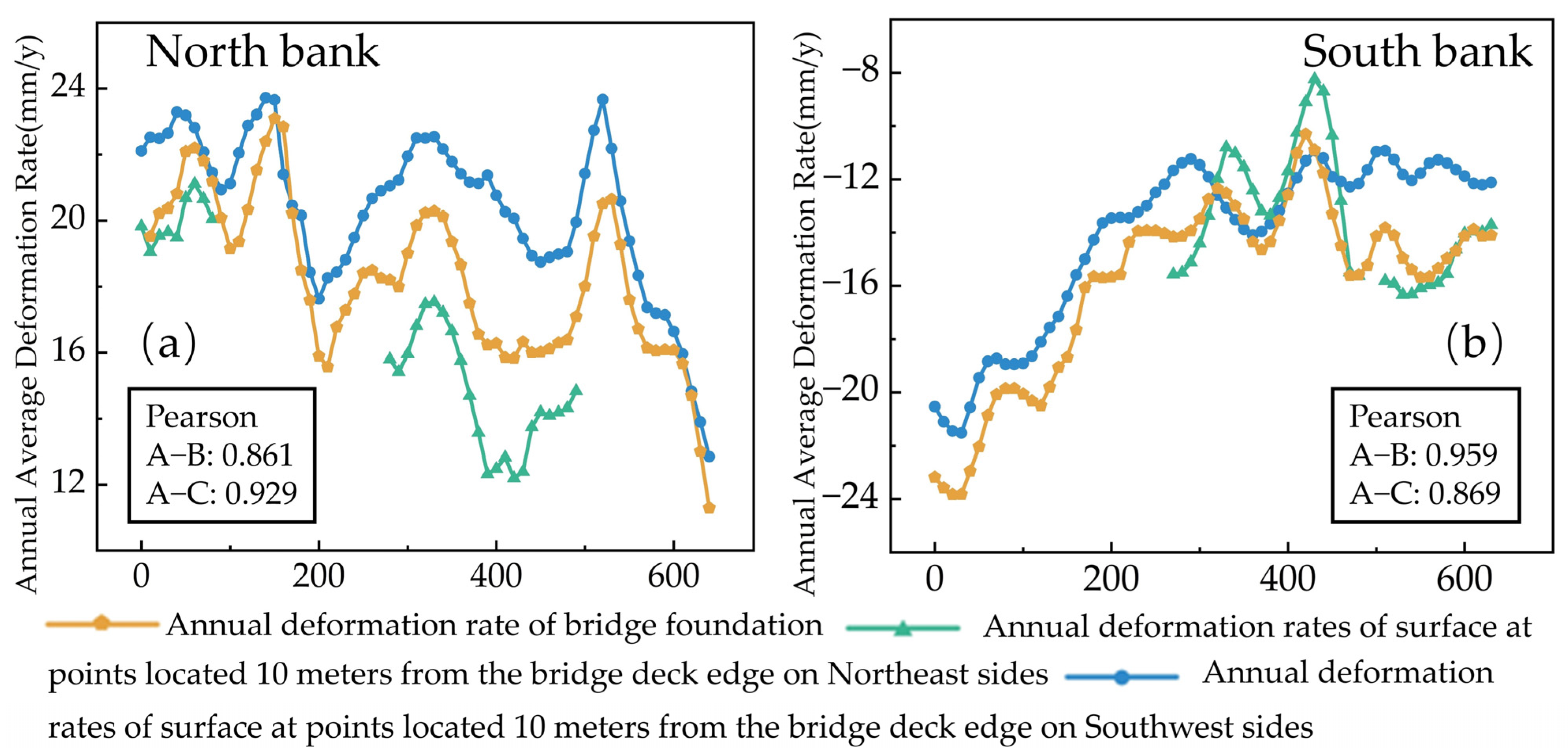
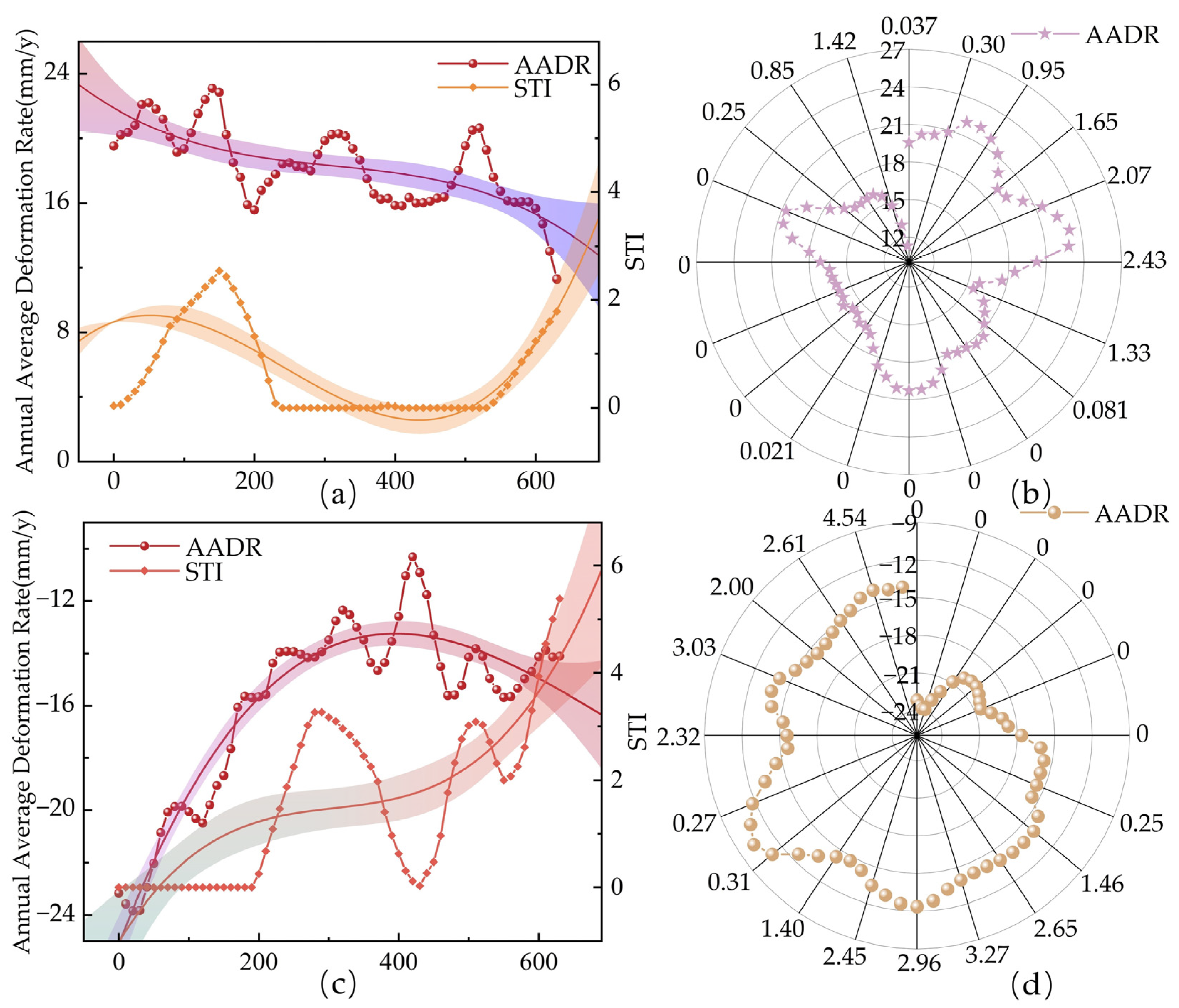

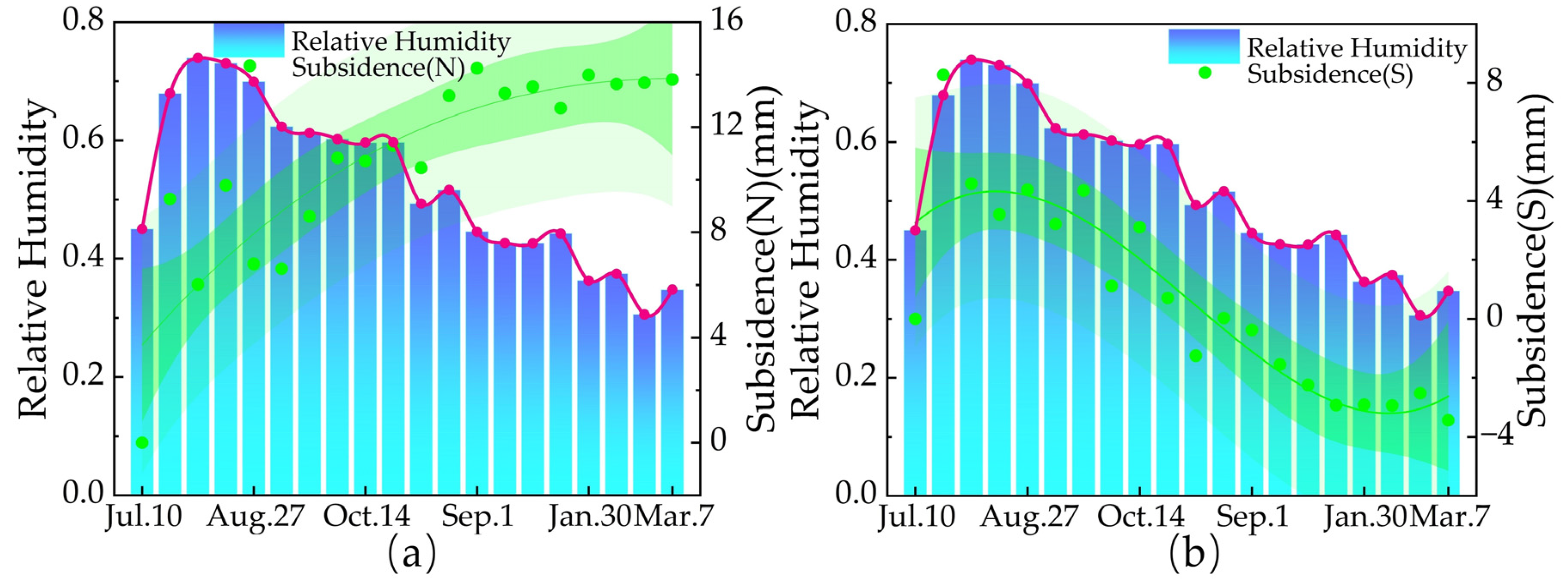


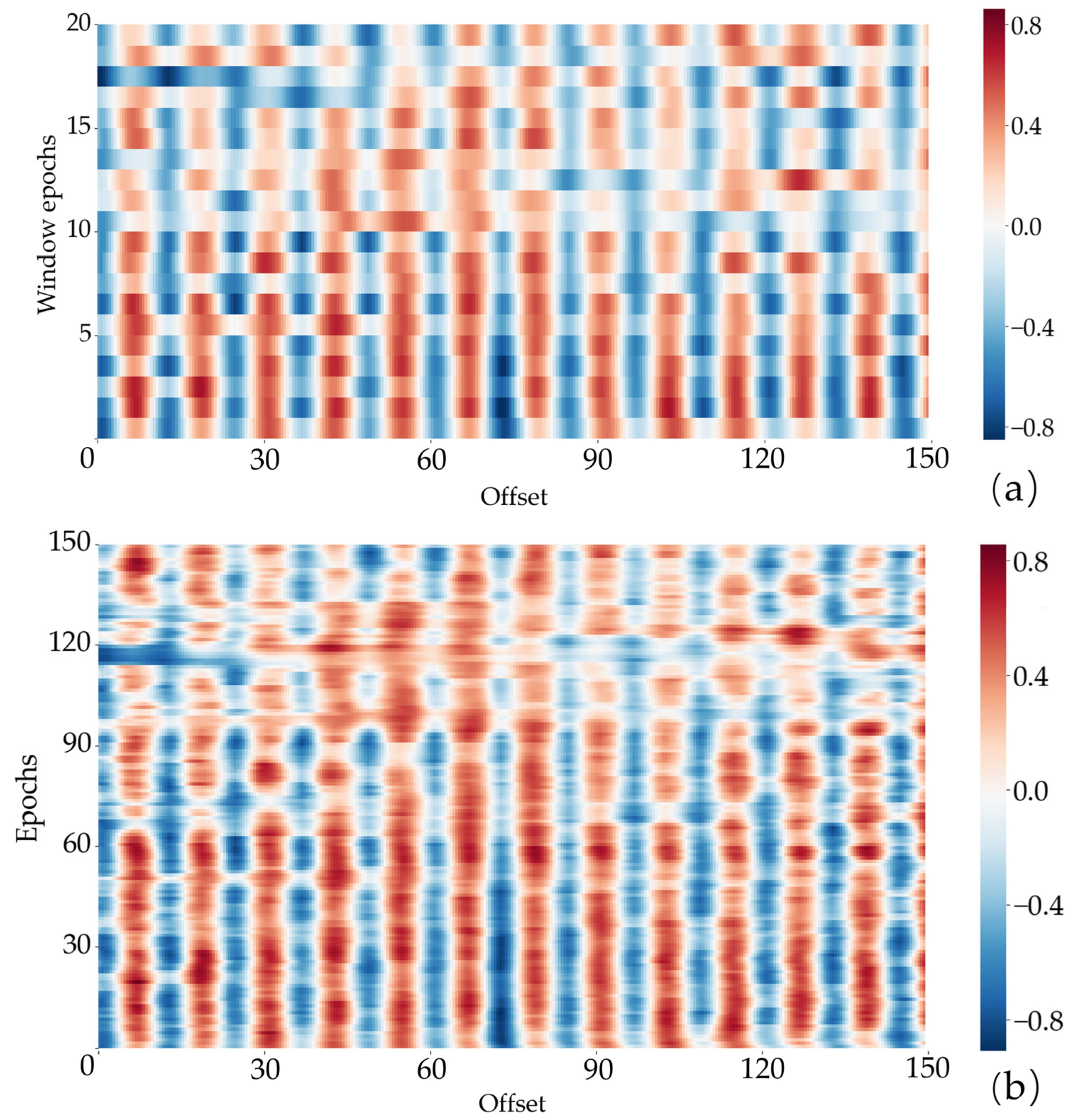
| Type | Website | Start Data | End Data |
|---|---|---|---|
| Sentinel-1A | https://search.asf.alaska.edu/, (accessed on 16 September 2024) | 10 July 2021 | 7 March 2022 |
| Satellite POD | https://step.esa.int/auxdata, (accessed on 16 September 2024) | 30 July 2021 | 27 March 2022 |
| SRTM DEM | https://srtm.csi.cgiar.org/, (accessed on 30 September 2024) | ||
| Geological Drilling Data | https://ndcp.cgsi.cn/, (accessed on 17 October 2024) | ||
| Dry Bulb Temperture | https://www.theweatheronline.net/, (accessed on 14 October 2024) | 10 July 2021 | 7 March 2022 |
| Relative Humidity | https://www.theweatheronline.net/, (accessed on 14 October 2024) | 10 July 2021 | 7 March 2022 |
| Point Name | P1 | P2 | P3 | P4 | P5 | P6 | |
|---|---|---|---|---|---|---|---|
| Relative Humidity | Correlation | −0.860 ** | −0.805 ** | −0.805 ** | −0.842 ** | −0.800 ** | −0.513 * |
| P(2-tailed) | 1.16 × 10−6 | 1.9 × 10−5 | 6.4 × 10−6 | 3.22 × 10−6 | 2.29 × 10−5 | 0.02078 | |
| Point Name | P7 | P8 | P9 | P10 | P11 | P12 | |
| Relative Humidity | Correlation | 0.961 ** | 0.920 ** | 0.928 ** | 0.929 ** | 0.929 ** | 0.934 ** |
| P(2-tailed) | 1.76 × 10−11 | 9.2 × 10−9 | 3.88 × 10−9 | 3.23 × 10−9 | 3.23 × 10−9 | 1.81 × 10−9 | |
| Point Name | P1 | P2 | P3 | P4 | P5 | P6 | |
|---|---|---|---|---|---|---|---|
| Dry Bulb Temperature | Correlation | −0.911 ** | −0.911 ** | −0.863 ** | −0.866 ** | −0.893 ** | −0.693 ** |
| P(2-tailed) | 2.34 × 10−8 | 2.34 × 10−8 | 9.62 × 10−7 | 7.97 × 10−7 | 1.16 × 10−7 | 7.01 × 10−4 | |
| Point Name | P7 | P8 | P9 | P10 | P11 | P12 | |
| Dry Bulb Temperature | Correlation | 0.908 ** | 0.869 ** | 0.827 ** | 0.866 ** | 0.881 ** | 0.866 ** |
| P(2-tailed) | 3.12 × 10−8 | 6.57 × 10−7 | 6.88 × 10−6 | 7.97 × 10−7 | 2.89 × 10−7 | 7.97 × 10−7 | |
Disclaimer/Publisher’s Note: The statements, opinions and data contained in all publications are solely those of the individual author(s) and contributor(s) and not of MDPI and/or the editor(s). MDPI and/or the editor(s) disclaim responsibility for any injury to people or property resulting from any ideas, methods, instructions or products referred to in the content. |
© 2025 by the authors. Licensee MDPI, Basel, Switzerland. This article is an open access article distributed under the terms and conditions of the Creative Commons Attribution (CC BY) license (https://creativecommons.org/licenses/by/4.0/).
Share and Cite
Zhang, K.; Xiao, W.; Zhu, H.; Ning, S.; Huang, S.; Jin, D.; A, R.; Thapa, B.R. Analysis of Uneven Settlement of Long-Span Bridge Foundations Based on SBAS-InSAR. Remote Sens. 2025, 17, 248. https://doi.org/10.3390/rs17020248
Zhang K, Xiao W, Zhu H, Ning S, Huang S, Jin D, A R, Thapa BR. Analysis of Uneven Settlement of Long-Span Bridge Foundations Based on SBAS-InSAR. Remote Sensing. 2025; 17(2):248. https://doi.org/10.3390/rs17020248
Chicago/Turabian StyleZhang, Kaixuan, Weifo Xiao, Haojie Zhu, Shaowei Ning, Shenjiang Huang, Dongxing Jin, Rong A, and Bhesh Raj Thapa. 2025. "Analysis of Uneven Settlement of Long-Span Bridge Foundations Based on SBAS-InSAR" Remote Sensing 17, no. 2: 248. https://doi.org/10.3390/rs17020248
APA StyleZhang, K., Xiao, W., Zhu, H., Ning, S., Huang, S., Jin, D., A, R., & Thapa, B. R. (2025). Analysis of Uneven Settlement of Long-Span Bridge Foundations Based on SBAS-InSAR. Remote Sensing, 17(2), 248. https://doi.org/10.3390/rs17020248









